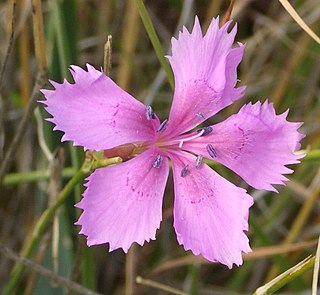
Dianthus is a genus of about 340 species of flowering plants in the family Caryophyllaceae, native mainly to Europe and Asia, with a few species in north Africa and in southern Africa, and one species in arctic North America. Common names include carnation, pink and sweet william.
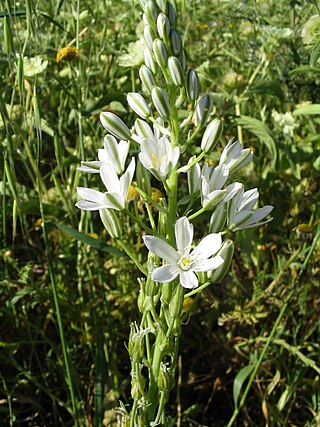
Ornithogalum narbonense, common names Narbonne star-of-Bethlehem, pyramidal star-of-Bethlehem and southern star-of-Bethlehem, is a herbaceous perennial flowering plant with underground bulbs, belonging to the genus Ornithogalum of the family Asparagaceae. The Latin name Ornithogalum of the genus, meaning "bird's milk", derives from the Greek, while the species name narbonense refers to the French town of Narbonne.
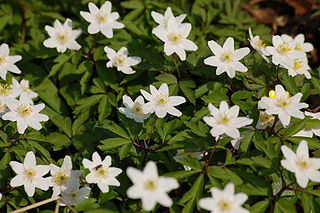
Anemonoides nemorosa, the wood anemone, is an early-spring flowering plant in the buttercup family Ranunculaceae, native to Europe. Other common names include windflower, European thimbleweed, and smell fox, an allusion to the musky smell of the leaves. It is a perennial herbaceous plant growing 5–15 cm (2–6 in) tall.

Dianthus barbatus, the sweet William, is a species of flowering plant in the family Caryophyllaceae, native to southern Europe and parts of Asia. It has become a popular ornamental garden plant. It is a herbaceous biennial or short-lived perennial plant growing to 13–92 cm tall, with flowers in a dense cluster of up to 30 at the top of the stems. Each flower is 2–3 cm diameter with five petals displaying serrated edges. Wild plants produce red flowers with a white base, but colours in cultivars range from white, pink, red, and purple to variegated patterns. The exact origin of its English common name is unknown but first appears in 1596 in botanist John Gerard's garden catalogue. The flowers are edible and may have medicinal properties. Sweet William attracts bees, birds, and butterflies.

Camellia japonica, known as common camellia, or Japanese camellia, is a species of Camellia, a flowering plant genus in the family Theaceae. There are thousands of cultivars of C. japonica in cultivation, with many colors and forms of flowers. Despite its common name, it is native to China, not Japan. The cultivation of Camellia japonica also started in China. Its widespread cultivation can be traced back to the Song Dynasty, when 15 varieties of Camellia japonica were recorded in literature. It was later introduced to Japan. It grows in forests, at altitudes of around 300–1,100 metres (980–3,600 ft).

Dianthus armeria, the Deptford pink or grass pink, is a species of Dianthus ("pink") native to most of Europe, from Portugal north to southern Scotland and southern Finland, and east to Ukraine and the Caucasus. It is naturalised in North America.

Astartea is a genus of flowering plants in the myrtle family, Myrtaceae. The genus is endemic to southwestern Western Australia. The genus name was inspired by Astarte, the Greek name for the goddess Ishtar.

Echinocereus reichenbachii is a perennial plant and shrub in the cactus family. The species is native to the Chihuahuan Desert and parts of northern Mexico and the southern United States, where they grow at elevations up to 1,500 meters (4,900 ft). This cactus earned the Royal Horticultural Society's Award of Garden Merit.

Oxalis incarnata is a species of flowering plant in the woodsorrel family known by the common names pale pink-sorrel and crimson woodsorrel. It is native to southern Africa, but it can be found on other continents where it is an introduced species, often the descendant of garden escapees. It is grown and kept as an ornamental plant. This is a perennial herb growing from a system of rhizomes and bulbs. The branching, hairless stem grows to nearly 30 centimeters in maximum length. There may be small bulblets located along the stem above ground. The leaves are borne on long petioles in erect bunches, each leaf made up of three leaflets. The solitary flower arises on a peduncle. Each flower has five white to light pink petals.

Silene campanulata is a species of flowering plant in the family Caryophyllaceae known by the common names Red Mountain catchfly and bell catchfly. It may be a synonym of Silene greenei.

Dianthus balbisii is a herbaceous perennial plant of the genus Dianthus of the family Caryophyllaceae. The genus name Dianthus derives from the Greek words for divine ("dios") and flower ("anthos"), while the species name balbisii honors the Italian botanist Giovanni Battista Balbis (1765–1831).
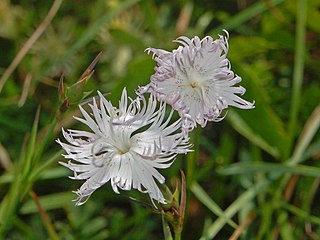
Dianthus monspessulanus, the fringed pink, is a herbaceous perennial plant of the genus Dianthus of the family Caryophyllaceae. The genus name Dianthus derives from the Greek words for divine ("dios") and flower ("anthos"), while the species name monspessulanus means "from Montpellier".

Dianthus pavonius, the peacock-eye pink, is a herbaceous perennial plant of the genus Dianthus of the family Caryophyllaceae.
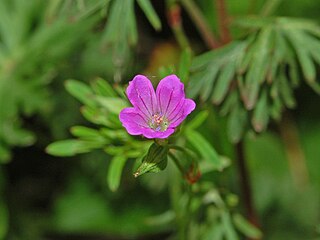
Geranium columbinum, common name long-stalked crane's-bill or longstalk cranesbill, is a herbaceous annual plant in the family Geraniaceae.

Epilobium parviflorum, commonly known as the hoary willowherb or smallflower hairy willowherb, is a herbaceous perennial plant of the family Onagraceae.

Iberis umbellata, common name garden candytuft or globe candytuft, is a herbaceous annual flowering plant of the genus Iberis and the family Brassicaceae.
Epilobium brunnescens is a flowering plant belonging to the willowherb genus Epilobium in the family Onagraceae. It is a small, creeping, perennial plant with white or pale pink flowers. It is native to New Zealand and south-east Australia and has been introduced to Northern Europe. Its common names include New Zealand willowherb in Great Britain and Ireland, creeping willowherb in New Zealand and bog willowherb for the Australian subspecies.
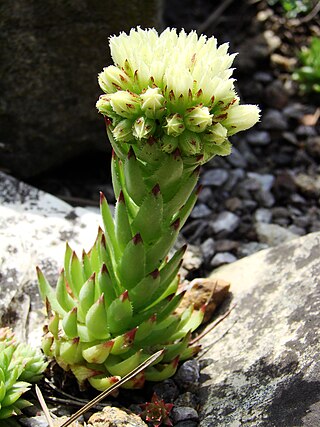
Jovibarba globifera, common name rolling hen-and-chicks, is a species of succulent flowering plant in the family Crassulaceae.

Sisyrinchium striatum, common names pale yellow-eyed-grass or satin flower, is an evergreen perennial plant in the family Iridaceae.

Micropera fasciculata, commonly known as the pale dismal orchid, is a species of epiphytic or lithophytic orchid with wiry stems forming large, tangled clumps. It has stiff, leathery leaves and flowering stems with between ten and twenty cream-coloured flowers with a white labellum. This orchid occurs in New Guinea, Queensland, the Solomon Islands and New Caledonia.





















